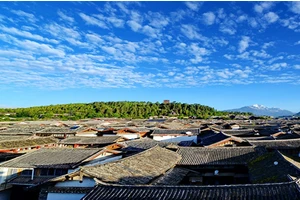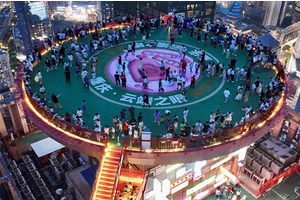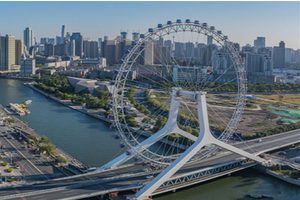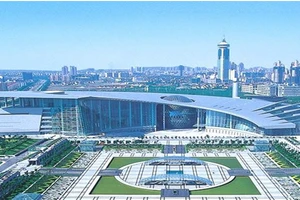Gaobeidian tourist attractions daquan ranking
What's interesting in Gaobeidian downtown?
The following tourist attractions are recommended:
1. China Door and Window Museum
China Door and Window Museum is located in China International Door and Window City, Gaobeidian City. It is the only professional museum in the world with the theme of doors and windows. The exhibition area of the museum is 7,000 square meters, and there are more than 3,000 exhibits in the collection. At present, there are more than 1,100 exhibits on display. Collect the world's top door and window design concepts, and show the doors and windows that meet any energy-saving standards and have different noise reduction levels in the world.
2. Gaobeidian Plant Park
Gaobeidian Botanical Park is located in the southeast of Gaobeidian City. It was completed in September 2004 with a total investment of 42 million yuan, covering a total area of 28 hectares, with a green area of 23 hectares and a water area of 1.7 hectares. With complete facilities, it is a comprehensive plant park integrating science popularization, fitness, leisure and entertainment. The whole park is divided into central landscape area, waterscape area, youth activity area and elderly activity area.
3. Gaobeidian Kaizenji
Kaizenji is located in the northeast corner of the old city site of Gaobeidian City, Hebei Province in the north of China. It is a Buddhist temple with the architectural style of Liao Dynasty (916-1125 AD). It is said that Kaizenji was built in the Tang Dynasty (618 ~ 907 AD), and most of the original buildings have been destroyed. Now, only the main hall built in Liao Dynasty and the Heavenly King Hall and King Kong Hall repaired by later generations are left.
1. Baigou Park, located at No.20 Youyi Road, Gaobeidian City, can be reached by bus No.641;
2. Botanical Park, near Century West Road in Gaobeidian City, which can be reached by bus No.103 and No.104;
3. Baiguo Gokurakuji, at No.188 North Street, Beicheng Street, Gaobeidian City, can be reached by bus No.621;
4. Century Square in Gaobeidian City, on Yingbin Road in Gaobeidian City, you can take bus No.101, 103 and 104 to reach it;
5. Gaobeidian++Temple, located 50 meters southwest of the intersection of Minzu West Road and++Temple Road in Gaobeidian City, can be reached by bus No.101, 102 and 621.
Six scenic spots in Gaobeidian
Gaobeidian has invested a total of 3.5 billion yuan to build six major scenic spots, including the world specialty town, Yanzhao Park, Jingnan Sports Town, Jikang Modern Agricultural Park, World Door and Window Town and Qinghe Bay Kangyang Town.
The main activities of the first tourism conference in Baoding are: "Tourism Plus" industry development summit forum, route observation, leaders' meeting, tourism culture exhibition and promotion meeting, tourism (cultural) industry Expo, large-scale cultural performances, and city-wide tourism promotion meeting.
Gaobeidian, located in Gaobeidian Town, Baoding City, Hebei Province, is a famous tourist attraction in China. There are many scenic spots in Gaobeidian, among which the six famous scenic spots include:
1. Yasukuni Shrine: It is an ancestral temple built to commemorate the soldiers and civilians of China who died in War of Resistance against Japanese Aggression, and it is a patriotic education base in China.
2. North China Guild Hall: It is an antique building, built in the Qing Dynasty, and is now a historical and cultural attraction and banquet center of Gaobeidian.
3. Yanwangfu: It was built by Zhu Di, the prince of Yan in the Ming Dynasty, for the convenience of living. Now it is a well-preserved building complex in the Ming Dynasty.
4. Dongyue Temple: It is an ancient Taoist temple, which was built in the Tang Dynasty and has now become the cultural heritage of Gaobeidian.
5. Baita Temple: It is a Buddhist temple, which was built in the Tang Dynasty and is famous for its ancient buildings and exquisite Buddha statues.
6. Yongding River Grand Canyon: It is a natural scenic spot with spectacular canyon scenery and fresh natural environment. It is a good place for tourism and vacation.
These are the six famous scenic spots in Gaobeidian. If you have the opportunity to travel to Gaobeidian, you can visit these scenic spots and feel the charm of history and nature.
There are many scenic spots in Gaobeidian, which are: Bailixia, Beijing Happy Water Cube, Beijing Wildlife Park, Baigou, Chengtian Water Park and Shidu Scenic Area. Bailixia Scenic Area is located in Sanpo Town, Laishui County, Baoding City, on the west side of Shidu Scenic Area, about 150 kilometers away from Beijing, and it is an important scenic spot in Yesanpo Scenic Area. Bailixia Scenic Area is dominated by long, narrow and deep canyons, where you can watch the spectacular and steep canyons and enjoy the streams and waterfalls in the valley.
Six scenic spots in Gaobeidian?
Gaobeidian, located in Gaobeidian Town, Baoding City, Hebei Province, is a famous tourist attraction in China. There are many scenic spots in Gaobeidian, among which the six famous scenic spots include:
1. Yasukuni Shrine: It is an ancestral temple built to commemorate the soldiers and civilians of China who died in War of Resistance against Japanese Aggression, and it is a patriotic education base in China.
2. North China Guild Hall: It is an antique building, built in the Qing Dynasty, and is now a historical and cultural attraction and banquet center of Gaobeidian.
3. Yanwangfu: It was built by Zhu Di, the prince of Yan in the Ming Dynasty, for the convenience of living. Now it is a well-preserved building complex in the Ming Dynasty.
4. Dongyue Temple: It is an ancient Taoist temple, which was built in the Tang Dynasty and has now become the cultural heritage of Gaobeidian.
5. Baita Temple: It is a Buddhist temple, which was built in the Tang Dynasty and is famous for its ancient buildings and exquisite Buddha statues.
6. Yongding River Grand Canyon: It is a natural scenic spot with spectacular canyon scenery and fresh natural environment. It is a good place for tourism and vacation.
These are the six famous scenic spots in Gaobeidian. If you have the opportunity to travel to Gaobeidian, you can visit these scenic spots and feel the charm of history and nature.
There are six scenic spots in Gaobeidian, namely Daqin Imperial Ruins Park, Gaobeidian Ancient City, Majiagou Scenic Area, Yayuan Teahouse, Oriental Wisdom Valley and Jingyuan Temple.
First of all, Daqin Empire Ruins Park is a famous cultural attraction in Gaobeidian, which preserves the historical relics of Daqin Empire here. Secondly, the ancient city of Gaobeidian is the only intact Ming Dynasty city wall in Beijing, and its historical and cultural value is extremely high. Majiagou Scenic Area is a natural scenic area, which brings together beautiful landscapes and national cultures. Yayuan Teahouse is a teahouse with traditional cultural characteristics, and you can taste authentic tea culture. Oriental Wisdom Valley is a science and technology park integrating science and technology, culture and art; Finally, Jingyuan Temple is a Buddhist cultural attraction with a history of thousands of years, and it has preserved many temple buildings and Buddhist cultural relics with historical and cultural values.
In short, the six scenic spots in Gaobeidian have their own characteristics and a long history, which is a good place for tourists to visit.
Introduction of Gaobeidian Lake?
Gaobeidian River section is the location of ancient Pingjin sluice water transport wharf, which is called Gaobeidian Lake because of its wide river surface and its location in Gaobeidian area.
In October 2020, the Gaobeidian Lake section of Tonghui River was basically navigable.
It is the first open river and lake in Beijing to realize navigation. The Gaobeidian Lake section of Tonghui River has a water area of 142,900 square meters.
After sailing from Caoyun Wharf, you can surround the lake from east to west, and you can enjoy the ancient and modern cultural buildings such as Pingjin Gate, Caoyun Wharf, Longwang Temple, Jiangjun Temple, Xidian Village Industrial Park, Gaobeidian Tongxin Bridge and the beautiful scenery along the Tonghui River.
Which province does Gaobeidian belong to?
Gaobeidian City is under the jurisdiction of Baoding City, Hebei Province. Gaobeidian is located in the middle of Hebei Province and southwest of Beijing. It is located in the hinterland of the triangle of Beijing, Tianjin and Baoding, and it is an important industrial city in the south of Beijing and the north of Baoding. The total area of the city is 672 square kilometers. By 2016, the total population of Gaobeidian City was 572,781. On April 9, 1993, Xincheng County was abolished and Gaobeidian City was established. In 2016, the city's GDP reached 14,513.59 million yuan, an increase of 9% over the previous year. Gaobeidian famous specialty has bean curd silk, and famous figures include Fan Yuqi. On January 25, 2019, it was selected as the national "Ping An Agricultural Machinery" demonstration county in 2018.
1. Gaobeidian belongs to Hebei Province.
Gaobeidian is located in Shijiazhuang City, Hebei Province, which is an administrative division of Shijiazhuang City, so it belongs to Hebei Province.
3. Gaobeidian, located in the middle of Hebei Province, is a county-level city in Hebei Province, with rich historical and cultural resources and tourist attractions, such as Gaobeidian Great Wall and Yanzhao Mystery Valley.
As a province in China, Hebei Province is rich in natural resources and human landscape, and it is a place worth exploring and visiting.
Gaobeidian, located in Hebei Province, China, is a county-level city in Baoding City, Hebei Province. It is located in the North China Plain, bordering Beijing in the north, and is an important node city in Beijing-Tianjin-Hebei region. Gaobeidian is a famous commercial and logistics center in China, with a developed transportation network and rich resource advantages. It has a long history and culture, and it is also one of the important tourist destinations in China. The development of Gaobeidian City has made important contributions to the economic prosperity of Hebei Province and even the whole North China.






